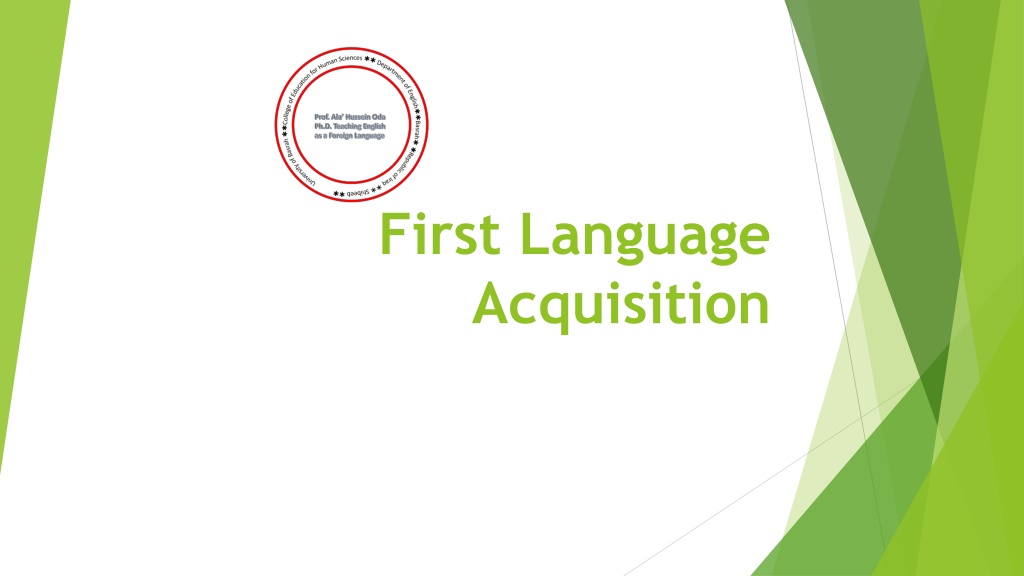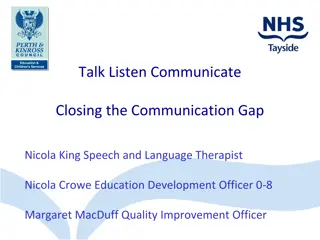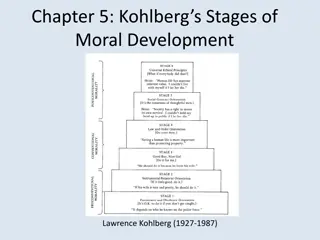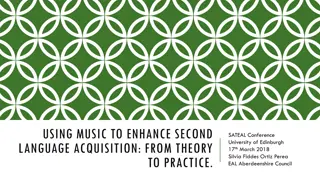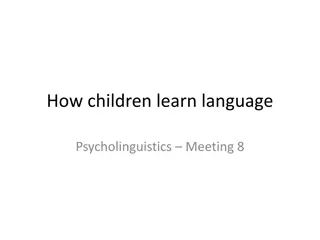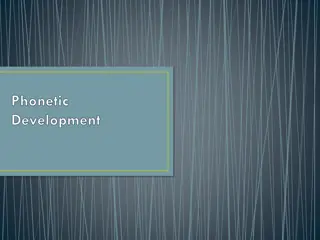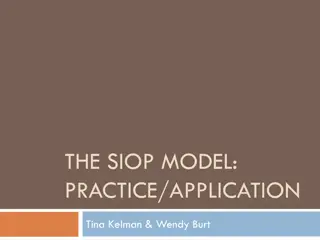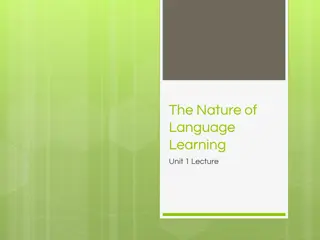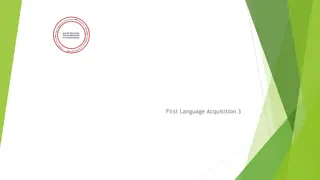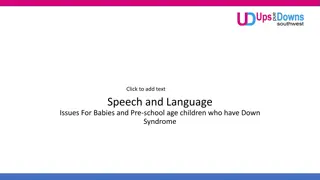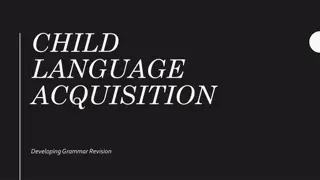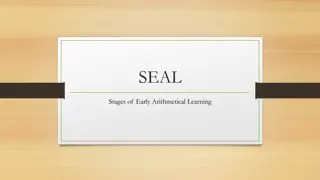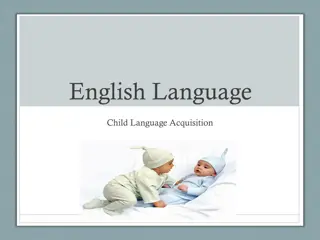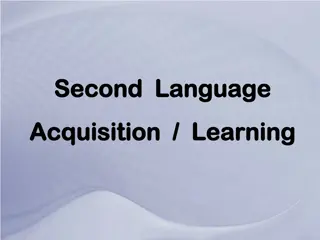Stages of First Language Acquisition in Children
First language acquisition in children progresses through distinct stages including cooing and babbling, the one-word stage, the two-word stage, and telegraphic speech. These stages mark the development of speech sounds, single-word utterances, two-word combinations, and more complex speech structures. By two and a half years old, children demonstrate a rapid expansion of their vocabulary and linguistic abilities.
- Language acquisition
- Child development
- Speech development
- Linguistic milestones
- Communication skills
Download Presentation

Please find below an Image/Link to download the presentation.
The content on the website is provided AS IS for your information and personal use only. It may not be sold, licensed, or shared on other websites without obtaining consent from the author. Download presentation by click this link. If you encounter any issues during the download, it is possible that the publisher has removed the file from their server.
E N D
Presentation Transcript
First Language Acquisition
Cooing and babbling The earliest use of speech-like sounds has been described as cooing. During the first few months of life, the child gradually becomes capable of producing sequences of vowel-like sounds, particularly high vowels similar to [i] and [u]. By four months of age, the developing ability to bring the back of the tongue into regular contact with the back of the palate allows the infant to create sounds similar to the velar consonants [k] and [g], hence the common description as cooing or gooing for this type of production. Speech perception studies have shown that by the time they are five months old, babies can already hear the difference between the vowels [i] and [a] and discriminate between syllables like [ba] and [ga].
The one-word stage Between twelve and eighteen months, children begin to produce a variety of recognizable single-unit utterances. This period, traditionally called the one-word stage, is characterized by speech in which single terms are uttered for everyday objects such as milk , cookie , cat , cup and spoon (usually pronounced [pun]). Other forms such as [s ] may occur in circumstances that suggest the child is producing a version of What s that, so the label one-word for this stage may be misleading and a term such as single-unit would be more accurate. We sometimes use the term holophrastic (meaning a single form functioning as a phrase or sentence) to describe an utterance that could be analyzed as a word, a phrase, or a sentence
The two-word stage Depending on what we count as an occurrence of two distinct words used together, the two-word stage can begin around eighteen to twenty months, as the child s vocabulary moves beyond fifty words. By the time the child is two years old, a variety of combinations, similar to baby chair, mommy eat, cat bad, will usually have appeared. The adult interpretation of such combinations is, of course, very much tied to the context of their utterance. The phrase baby chair may be taken as an expression of possession (= this is baby s chair), or as a request (= put baby in chair), or as a statement (= baby is in the chair), depending on different circumstances.
Telegraphic speech Between two and two-and-a-half years old, the child begins producing a large number of utterances that could be classified as multiple-word speech. The salient feature of these utterances ceases to be the number of words, but the variation in word-forms that begins to appear. Before we investigate this development, we should note a stage that is described as telegraphic speech. This is characterized by strings of words (lexical morphemes) in phrases or sentences such as this shoe all wet, cat drink milk and daddy go bye-bye. The child has clearly developed some sentence-building capacity by this stage and can get the word order correct
Bythe age of two-and-a-half years, the childs vocabulary is expanding rapidly and the child is initiating more talk while increased physical activity includes running and jumping. By three, the vocabulary has grown to hundreds of words and pronunciation has become closer to the form of adult language. At this point, it is worth considering what kind of influence, if any, the adults have in the development of the child s speech
Basic Requirements During the first two or three years of development, a child requires interaction with other language-users in order to bring this general language capacity into operation with a particular language such as English. We have already seen, in the case of Genie (chapter 13), that a child who does not hear or is not allowed to use language will learn no language. We have also identified the importance of cultural transmission (chapter 2), meaning that the language a child learns is not genetically inherited, but is acquired in a particular language-using environment.
The child must also be physically capable of sending and receiving sound signals in a language. All infants make cooing and babbling noises during their first year, but congenitally deaf infants stop after about six months. So, inorder to speak a language, a child must be able to hear that language being used. By itself, however, hearing language sounds is not enough.
The Acquisition Schedule All normal children develop language at roughly the same time, along much the same schedule. Since we could say the same thing for sitting up, standing, walking, using the hands and many other physical activities, it would seem that the language acquisition schedule has the same basis as the biologically determined development of motor skills. This biological schedule is tied very much to the maturation of the infant s brain
We could think of the child as having the biological capacity to cope with distinguishing certain aspects of linguistic input at different stages during the early years of life. At one month, for example, an infant is capable of distinguishing between sounds such as [ba] and [pa]
What this acquisition capacity then requires is a sufficiently constant type of input from which the basis of the regularities in a particular language can be worked out. In this view, young children are seen as actively acquiring the language by identifying the regularities in what is heard and then applying those regularities in what they say.
Caregiver Speech Under normal circumstances, human infants are certainly helped in their language acquisition by the typical behavior of older children and adults in the home environment. Adults such as mom, dad and the grandparents tend not to address the little creature before them as if they are involved in normal adult to- adult conversation.
There is not much of this: Well, John Junior, shall we invest in blue chip industrials, or would grain futures offer better short-term prospects? However, there does seem to be a lot of this: Oh, goody, now Daddy push choo choo? The characteristically simplified speech style adopted by someone who spends a lot of time interacting with a young child is called caregiver speech.
Salient features of this type of speech (also called motherese or child directed speech ) are the frequent use of questions, often using exaggerated intonation, extra loudness and a slower tempo with longer pauses. In the earlystages, this type of speech also incorporates a lot of forms associated with babytalk . These are either simplified words (tummy, nana) or alternative forms, with repeated simple sounds and syllables, for things in the child s environment (choo-choo, poo-poo, pee-pee, wawa).
mother: Look! child: (touches pictures) mother: What are those? child: (vocalizes a babble string and smiles) mother: Yes, there are rabbits. child: (vocalizes, smiles looks up at mother) mother: (laughs) Yes, rabbit. child: (vocalizes, smiles) mother: Yes. (laughs)
Caregiver speech is also characterized by simple sentence structures and a lot of repetition. If the child is indeed in the process of working out a system of putting sounds and words together, then these simplified models produced by the interacting adult may serve as good clues to the basic structural organization involved.
